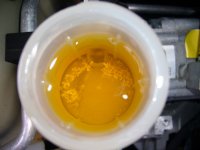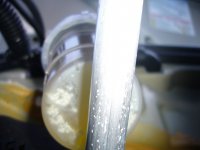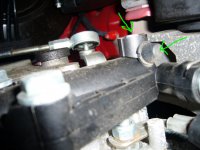I noticed yesterday that the fluid in the clutch master cylinder reservoir had darkened somewhat & that a white film appeared to have formed at the bottom. The car is 20 months old with about 8000 miles on the clock.
Removing the cap & black rubber diaphragm revealed a layer of white semicrystalline sediment. The attached photo isn't the best - it's taken looking down through the fluid - but it illustrates the problem. I've left in in hi-res so you can see the detail - just click to enlarge.
For now, I've vacuumed out the sediment & replaced the fluid in the reservoir, but obviously this is going to need a complete flush. Annoyingly it looks like it's going to be necessary to remove the battery & battery tray to get access to the bleed screw on the slave cylinder.
I'd like to think this is a one-off. I'd be grateful if those of you who know what to look for would have a look at their clutch master & report back. Please only remove the cap & diaphragm if you're sure what you're doing.
Many thanks
John
Removing the cap & black rubber diaphragm revealed a layer of white semicrystalline sediment. The attached photo isn't the best - it's taken looking down through the fluid - but it illustrates the problem. I've left in in hi-res so you can see the detail - just click to enlarge.
For now, I've vacuumed out the sediment & replaced the fluid in the reservoir, but obviously this is going to need a complete flush. Annoyingly it looks like it's going to be necessary to remove the battery & battery tray to get access to the bleed screw on the slave cylinder.
I'd like to think this is a one-off. I'd be grateful if those of you who know what to look for would have a look at their clutch master & report back. Please only remove the cap & diaphragm if you're sure what you're doing.
Many thanks
John
Attachments
Last edited:









